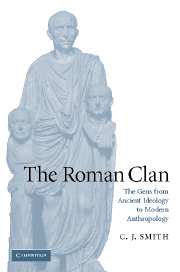Book contents
- Frontmatter
- Contents
- List of illustrations
- Preface
- List of abbreviations
- General introduction
- Part I THE EVIDENCE FOR THE GENS
- Part II TOWARDS AN INTERPRETATION OF THE GENS
- Chapter 5 The Roman community
- Chapter 6 The Roman curiae
- Chapter 7 The patricians and the land
- Chapter 8 The patriciate
- Chapter 9 Warfare in the regal and early Republican periods
- Chapter 10 Explaining the gens
- Chapter 11 Roman history and the modern world
- Appendix 1 Dionysius of Halicarnassus on the Roman curiae and religion
- Appendix 2 The missing curiae
- Select bibliography
- General index
- Index of ancient persons
- Index of passages discussed
Chapter 7 - The patricians and the land
Published online by Cambridge University Press: 22 September 2009
- Frontmatter
- Contents
- List of illustrations
- Preface
- List of abbreviations
- General introduction
- Part I THE EVIDENCE FOR THE GENS
- Part II TOWARDS AN INTERPRETATION OF THE GENS
- Chapter 5 The Roman community
- Chapter 6 The Roman curiae
- Chapter 7 The patricians and the land
- Chapter 8 The patriciate
- Chapter 9 Warfare in the regal and early Republican periods
- Chapter 10 Explaining the gens
- Chapter 11 Roman history and the modern world
- Appendix 1 Dionysius of Halicarnassus on the Roman curiae and religion
- Appendix 2 The missing curiae
- Select bibliography
- General index
- Index of ancient persons
- Index of passages discussed
Summary
INTRODUCTION
In the previous chapter, we set out the wider political context of the early Republic through consideration of the curiae. Our argument was that the curiae were a vital aspect of the Roman constitution, and that one could not identify the patrician gentes neatly with the curiae, but had to develop a more complex and sophisticated analysis. My intention was to clarify the political society in the early Republic, by reference to the assembly structures. In this chapter, we turn to the patriciate itself. Modern scholarship tends to be comfortable with the idea that patricians like the Claudii and the Fabii were organised into gentes; and we have seen Livy report a claim that only patricians were organised by gentes. So who were the patricians?
The following chapters address three key themes. I begin, not with the patriciate itself, but with an investigation of the relationship between individual gentes and ownership of land, starting with the issue of the significance of the fact that some tribes at least bear the names of patrician gentes. The purpose of beginning with the issue of land-ownership is twofold: it addresses directly one of the major areas of confrontation in the sources between patricians and plebeians, and it reveals more about the way in which an economic explanation of the distinctions between social groups at Rome might be made.
- Type
- Chapter
- Information
- The Roman ClanThe Gens from Ancient Ideology to Modern Anthropology, pp. 235 - 250Publisher: Cambridge University PressPrint publication year: 2006

